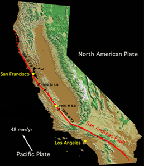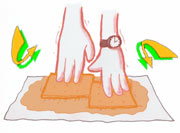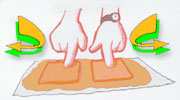

An earthquake is a sudden release of stored energy. Earthquakes occur when slow but powerful tectonic forces cause stress to build up in the Earth’s crust. When the stresses get large enough, slippage is triggered along fractures in the rock known as faults. The sudden slipping motion along a fault causes vibrations known as seismic waves to form and travel away from the zone of slippage. Several meters of slip along a large fault causes a major earthquake; a few centimeters of slip on a small fault (perhaps the size of a soccer field) would cause a small earthquake. Larger earthquakes cause stronger seismic waves.
Seismic waves that travel through the rocks of the Earth’s crust are similar to the ripples that spread across the surface of a pond after a rock splashes into the still water. However, seismic waves travel much faster than water waves. The rumbling noises or shaking motion that you might experience during an earthquake are caused by seismic waves passing through the rocks beneath our feet.
Seismographs are sensitive instruments that record the vibrations of passing seismic waves. Using the recordings from a group of seismograph stations (a seismic network), a seismologist can determine the location (epicenter), depth (focus), and size magnitude) of an earthquake. The size of an earthquake is rated on a magnitude scale. The most popular magnitude scale is the Richter scale but the Moment magnitude scale is more accurate. On either scale, an increase of one magnitude unit indicates a ten-fold increase in seismic shaking.
Magnitude 1–2
|
Only detected by instruments such as seismographs (over half a million per year). |
Magnitude
5–6
|
Felt strongly. There is some building damage (hundreds per year). |
Magnitude
2–3
|
Detected by instruments and felt a little by people (hundreds of thousands per year). | Magnitude
6–7
|
Severe. Buildings and chimneys collapse (20 to 200 per year). |
Magnitude
3–4
|
Felt slightly. Bells might ring, lights might move (tens of thousands per year). | Magnitude
7–8
|
Severe. Buildings collapse and cracks form in the ground (10 to 20 per year). |
Magnitude
4–5
|
Felt strongly. Some glass and building damage occurs (thousands per year). | Magnitude 8–9
|
Mass destruction. Buildings, bridges, and roads collapse (one per year at magnitude 8, one per decade at 9 magnitude). |
 Whose
fault is this?
Whose
fault is this?
What if you went outside after an earthquake and found the rasberries your family planted in the front yard were growing in front of your next door neighbor's house (and in your yard were the roses from the next house)? This is what happened in San Francisco along one of the most famous fault lines in the world— the San Andreas Fault in California, a 600 -mile boundary where the American and Pacific Plates meet. In 1906, there was an earthquake along this fault line and the earth moved about 20 feet in less than a minute! Wonder who got to eat the ripe berries?
 A
crack in the earth's crust is called a fault. The large crack where
two huge earth plates move against each other is a fault line. Fault
lines are where the action happens.
A
crack in the earth's crust is called a fault. The large crack where
two huge earth plates move against each other is a fault line. Fault
lines are where the action happens.
What you'll need:
 Put
two graham crackers side by side, and slide one up away from you
and the other one down toward you.
Put
two graham crackers side by side, and slide one up away from you
and the other one down toward you.
When plates move past each other like this, things don't exactly go smoothly. In fact, the plates usually get stuck on each other and then give a lurch and move on, sending waves of vibrations through the earth's interior (much like the circular waves that ripple out when you drop a pebble in the water). These vibrations are so powerful the we have a special name for them— earthquake!
 Put
two graham crackers very close to each other on the wax paper and
slowly push them together.
Put
two graham crackers very close to each other on the wax paper and
slowly push them together.
You've made a rift, or big crack in the ocean floor. As the plates separate, magma oozes up from below and makes new ocean floor or creates underwater mountain ranges.
This delicious and fun project and many
more can be found in GEOLOGY ROCKS!,
a Williamson
Publishing book by Cindy Blombaum